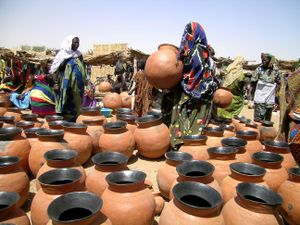صنغاي (شعب)
 A man of the Songhai people from Mali, in 2012. | |
| إجمالي التعداد | |
|---|---|
| Approx. 4.5 million (2010) | |
| المناطق ذات التجمعات المعتبرة | |
| West Africa | |
| اللغات | |
| Songhay languages, French | |
| الدين | |
| Predominantly Muslim | |
| الجماعات العرقية ذات الصلة | |
| Djerma, other Nilo-Saharan groups, Mandé, Soninke, Fula (in Nigeria and Mali), Hausa, Toubou, Kanuri (in Nigeria and Niger). |
The Songhai people (also Songhay or Sonrai) are an ethnic group in West Africa who speak the various Songhai languages. Their history and lingua franca is linked to the Songhai Empire which dominated the western Sahel in the 15th and 16th century. Predominantly a Muslim community, the Songhai are found primarily throughout Nigeria and Niger in the Western sudanic region (not the country). The name Songhai was historically neither an ethnic nor linguistic designation, but a name for the ruling caste of the Songhay Empire. Speakers in Mali have adopted it as an ethnic designation[1] but other Songhay-speaking groups identify themselves by other ethnic terms such as Zarma (or Djerma, the largest subgroup of the Songhai) or Isawaghen. The dialect of Koyraboro Senni spoken in Gao is unintelligible to speakers of the Zarma dialect of Niger, according to at least one report.[2] The Songhay languages are commonly taken to be Nilo-Saharan but this classification remains controversial: Dimmendaal (2008) believes that for now it is best considered an independent language family.[3]
History
Society and culture

Social stratification
Livelihood
The Songhai people cultivate cereals, raise small herds of cattle and fish in the Niger Bend area where they live.[4] They have traditionally been one of the key West African ethnic groups associated with caravan trade.[4]
See also
References
- ^ Heath, Jeffrey. 1999. A grammar of Koyraboro (Koroboro) Senni: the Songhay of Gao. Köln: Köppe. 402 pp
- ^ "Niger". Ethnologue. Retrieved 4 نوفمبر 2015.
- ^ Dimmendaal, Gerrit. 2008. Language Ecology and Linguistic Diversity on the African Continent. Language and Linguistics Compass 2(5): 843ff.
- ^ أ ب خطأ استشهاد: وسم
<ref>غير صحيح؛ لا نص تم توفيره للمراجع المسماةsbrit